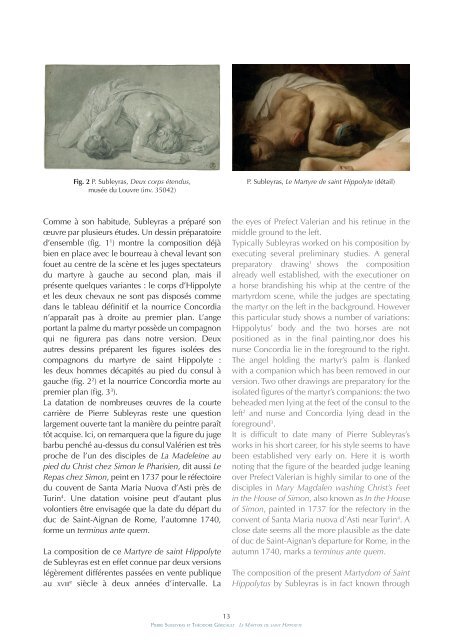You also want an ePaper? Increase the reach of your titles
YUMPU automatically turns print PDFs into web optimized ePapers that Google loves.
Fig. 2 P. Subleyras, Deux corps étendus,<br />
musée du Louvre (inv. 35042)<br />
P. Subleyras, Le <strong>Marty</strong>re <strong>de</strong> saint Hippolyte (détail)<br />
Comme à son habitu<strong>de</strong>, Subleyras a préparé son<br />
œuvre par plusieurs étu<strong>de</strong>s. Un <strong>de</strong>ssin préparatoire<br />
d’ensemble (fig. 1 1 ) montre la composition déjà<br />
bien en place avec le bourreau à cheval levant son<br />
fouet au centre <strong>de</strong> la scène et les juges spectateurs<br />
du martyre à gauche au second plan, mais il<br />
présente quelques variantes : le corps d’Hippolyte<br />
et les <strong>de</strong>ux chevaux ne sont pas disposés comme<br />
dans le tableau définitif et la nourrice Concordia<br />
n’apparaît pas à droite au premier plan. L’ange<br />
portant la palme du martyr possè<strong>de</strong> un compagnon<br />
qui ne figurera pas dans notre version. Deux<br />
autres <strong>de</strong>ssins préparent les figures isolées <strong>de</strong>s<br />
compagnons du martyre <strong>de</strong> saint Hippolyte :<br />
les <strong>de</strong>ux hommes décapités au pied du consul à<br />
gauche (fig. 2 2 ) et la nourrice Concordia morte au<br />
premier plan (fig. 3 3 ).<br />
La datation <strong>de</strong> nombreuses œuvres <strong>de</strong> la courte<br />
carrière <strong>de</strong> Pierre Subleyras reste une question<br />
largement ouverte tant la manière du peintre paraît<br />
tôt acquise. Ici, on remarquera que la figure du juge<br />
barbu penché au-<strong>de</strong>ssus du consul Valérien est très<br />
proche <strong>de</strong> l’un <strong>de</strong>s disciples <strong>de</strong> La Ma<strong>de</strong>leine au<br />
pied du Christ chez Simon le Pharisien, dit aussi Le<br />
Repas chez Simon, peint en 1737 pour le réfectoire<br />
du couvent <strong>de</strong> Santa Maria Nuova d’Asti près <strong>de</strong><br />
Turin 4 . Une datation voisine peut d’autant plus<br />
volontiers être envisagée que la date du départ du<br />
duc <strong>de</strong> <strong>Saint</strong>-Aignan <strong>de</strong> Rome, l’automne 1740,<br />
forme un terminus ante quem.<br />
La composition <strong>de</strong> ce <strong>Marty</strong>re <strong>de</strong> saint Hippolyte<br />
<strong>de</strong> Subleyras est en effet connue par <strong>de</strong>ux versions<br />
légèrement différentes passées en vente publique<br />
au xviii e siècle à <strong>de</strong>ux années d’intervalle. La<br />
the eyes <strong>of</strong> Prefect Valerian and his retinue in the<br />
middle ground to the left.<br />
Typically Subleyras worked on his composition by<br />
executing several preliminary studies. A general<br />
preparatory drawing 1 shows the composition<br />
already well established, with the executioner on<br />
a horse brandishing his whip at the centre <strong>of</strong> the<br />
martyrdom scene, while the judges are spectating<br />
the martyr on the left in the background. However<br />
this particular study shows a number <strong>of</strong> variations:<br />
<strong>Hippolytus</strong>’ body and the two horses are not<br />
positioned as in the final painting,nor does his<br />
nurse Concordia lie in the foreground to the right.<br />
<strong>The</strong> angel holding the martyr’s palm is flanked<br />
with a companion which has been removed in our<br />
version. Two other drawings are preparatory for the<br />
isolated figures <strong>of</strong> the martyr’s companions: the two<br />
behea<strong>de</strong>d men lying at the feet <strong>of</strong> the consul to the<br />
left 2 and nurse and Concordia lying <strong>de</strong>ad in the<br />
foreground 3 .<br />
It is difficult to date many <strong>of</strong> Pierre Subleyras’s<br />
works in his short career, for his style seems to have<br />
been established very early on. Here it is worth<br />
noting that the figure <strong>of</strong> the bear<strong>de</strong>d judge leaning<br />
over Prefect Valerian is highly similar to one <strong>of</strong> the<br />
disciples in Mary Magdalen washing Christ’s Feet<br />
in the House <strong>of</strong> Simon, also known as In the House<br />
<strong>of</strong> Simon, painted in 1737 for the refectory in the<br />
convent <strong>of</strong> Santa Maria nuova d’Asti near Turin 4 . A<br />
close date seems all the more plausible as the date<br />
<strong>of</strong> duc <strong>de</strong> <strong>Saint</strong>-Aignan’s <strong>de</strong>parture for Rome, in the<br />
autumn 1740, marks a terminus ante quem.<br />
<strong>The</strong> composition <strong>of</strong> the present <strong>Marty</strong>dom <strong>of</strong> <strong>Saint</strong><br />
<strong>Hippolytus</strong> by Subleyras is in fact known through<br />
13<br />
Pierre SubleyraS et théodore GériCault LE MARTYRE DE SAiNT HiPPOLYTE
















